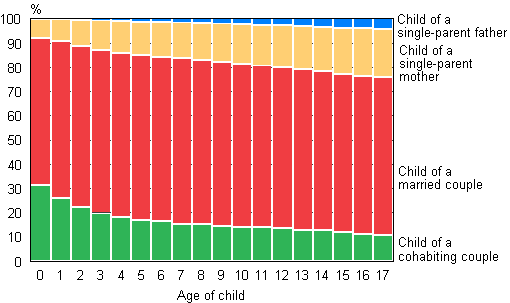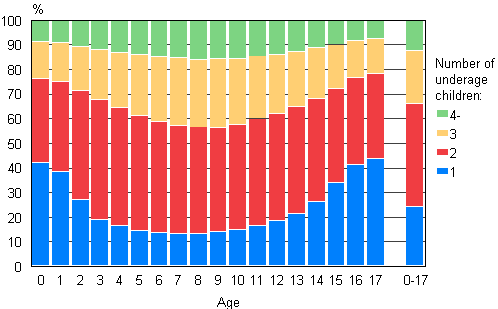5. One-fifth of 17-year-olds live with the mother only
Families with children can also be examined by taking the child as the statistical unit instead of the family. Then the results are slightly different. For example, 61 per cent of the families with underage children are those of married couples, but 66 per cent of all children live in families of married couples, because these families have a higher average number of children than families of cohabiting couples or one-parent families. When the children of cohabiting couples and registered partnerships are included, 83 per cent of underage children live in two-parent families. The proportion has fallen by seven percentage points from 1985.
Table 8. Children aged under 18 by type of family in 1985–2010
| Year | Total | Married couple | Registered partnership | Cohabiting couple | Mother | Father |
| 1985 | 1 136 027 | 959 580 | .. | 61 386 | 102 413 | 12 648 |
| 1990 | 1 135 686 | 916 855 | .. | 91 164 | 113 184 | 14 483 |
| 1995 | 1 150 562 | 858 255 | .. | 125 222 | 148 706 | 18 379 |
| 2000 | 1 116 687 | 777 447 | .. | 156 411 | 162 544 | 20 285 |
| 2005 | 1 084 865 | 727 638 | 131 | 172 898 | 162 875 | 21 323 |
| 2006 | 1 080 728 | 721 911 | 183 | 175 516 | 161 834 | 21 284 |
| 2007 | 1 076 522 | 716 804 | 216 | 176 801 | 161 184 | 21 517 |
| 2008 | 1 071 800 | 713 202 | 277 | 175 986 | 160 730 | 21 605 |
| 2009 | 1 068 554 | 708 684 | 331 | 175 951 | 161 755 | 21 833 |
| 2009 | 1 068 554 | 708 684 | 331 | 175 951 | 161 755 | 21 833 |
| 2010 | 1 064 470 | 704 953 | 397 | 175 563 | 161 427 | 22 130 |
| Per cent | ||||||
| 1985 | 100,0 | 84,5 | .. | 5,4 | 9,0 | 1,1 |
| 1990 | 100,0 | 80,7 | .. | 7,9 | 10,0 | 1,3 |
| 1995 | 100,0 | 74,6 | .. | 10,9 | 12,9 | 1,6 |
| 2000 | 100,0 | 69,6 | .. | 14,0 | 14,6 | 1,8 |
| 2005 | 100,0 | 67,1 | 0,0 | 15,9 | 15,0 | 2,0 |
| 2006 | 100,0 | 66,8 | 0,0 | 16,2 | 15,0 | 2,0 |
| 2007 | 100,0 | 66,6 | 0,0 | 16,4 | 15,0 | 2,0 |
| 2008 | 100,0 | 66,5 | 0,0 | 16,4 | 15,0 | 2,0 |
| 2009 | 100,0 | 66,3 | 0,0 | 16,5 | 15,1 | 2,0 |
| 2010 | 100,0 | 66,2 | 0,0 | 16,5 | 15,2 | 2,1 |
Of all babies aged under one, 92 per cent live with both parents and eight per cent with a single mother (Figure 9). In one decade, the first mentioned percentage has risen by only one percentage point while the latter has remained unchanged.
The share of children living with their father or mother rises with age. Twenty per cent of 17-year-old children live with the mother only; one decade ago the share was 17 per cent. Respectively, four per cent live with the father only, which is the same proportion as ten years earlier.
Figure 9. Children by type of family and age in 2010, relative breakdown

5.1 Three out of four children have at least one sibling at home
Although 44 per cent of families with children had only one child at the end of 2010, only 24 per cent of the children in these families had no siblings. The status of an only child is temporary for many of these children, as the majority of them will have a sibling later on. Some of these children may also have had an older sibling who has already turned 18 or moved away from home.
At the end of 2010, altogether 42 per cent of all children lived with one sibling and as many as 34 per cent of all children had at least two siblings living at home. In 1985, only 27 per cent of all children had at least two siblings at home.
Table 9. Children by number of underage children in the family in 1985–2010
| Year | Total | Number of underage children in families | |||
| 1 | 2 | 3 | 4- | ||
| 1985 | 1 136 027 | 306 784 | 518 206 | 221 211 | 89 826 |
| 1990 | 1 135 751 | 286 529 | 500 680 | 243 504 | 105 038 |
| 1995 | 1 150 562 | 284 915 | 484 092 | 257 283 | 124 272 |
| 2000 | 1 116 687 | 268 369 | 461 516 | 255 075 | 131 727 |
| 2005 | 1 084 865 | 255 549 | 451 758 | 245 325 | 132 233 |
| 2006 | 1 080 728 | 254 705 | 451 428 | 242 382 | 132 213 |
| 2007 | 1 076 522 | 254 832 | 450 088 | 238 782 | 132 820 |
| 2008 | 1 071 800 | 253 841 | 449 016 | 235 650 | 133 293 |
| 2009 | 1 068 554 | 254 457 | 447 554 | 232 584 | 133 959 |
| 2010 | 1 064 470 | 254 551 | 445 192 | 230 580 | 134 147 |
| Per cent | |||||
| 1985 | 100,0 | 27,0 | 45,6 | 19,5 | 7,9 |
| 1990 | 100,0 | 25,2 | 44,1 | 21,4 | 9,2 |
| 1995 | 100,0 | 24,8 | 42,1 | 22,4 | 10,8 |
| 2000 | 100,0 | 24,0 | 41,3 | 22,8 | 11,8 |
| 2005 | 100,0 | 23,6 | 41,6 | 22,6 | 12,2 |
| 2006 | 100,0 | 23,6 | 41,8 | 22,4 | 12,2 |
| 2007 | 100,0 | 23,7 | 41,8 | 22,2 | 12,3 |
| 2008 | 100,0 | 23,7 | 41,9 | 22,0 | 12,4 |
| 2009 | 100,0 | 23,8 | 41,9 | 21,8 | 12,5 |
| 2010 | 100,0 | 23,9 | 41,8 | 21,7 | 12,5 |
Figure 10 illustrates the cross-sectional nature of family statistics. It shows the ages of children in families by the number of children in the family. Here all children living at home and aged under 18 are taken into account when determining the status of an only child. Of the 0-year-olds, 42 per cent are without siblings, i.e. they are the first-borns in their families. The share of children without siblings is the lowest, or 13 per cent, among the 6 to 8 age cohort.
A second child has most likely been born to a family at the latest by the time the first-born is aged around seven. On the other hand, the older sibling has only on rare occasions reached the age of 18. Since it can be assumed that some of the 7-year-old children will still have a sibling and some of them already have one who has left home, it can be concluded that some ten per cent of children will remain permanently without siblings. The same results are attained if the number of children is calculated with a table containing all Finnish women according to the number of children born to them.
Figure 10 indicates that a child’s family is at its largest when he/she is aged between 8 and 9. In all, 44 per cent of children of that age live in families with at least three underage children. The proportion is the same as in the previous year.
Figure 10. Children by age and number of children aged under 18 in the family in 2010

5.2 Children in reconstituted families are most often the mother's
As in the previous year, 110,000 children (10% of all children) aged under 18 are raised in reconstituted families. Of them, 33,100 are the spouses' common children, that is, born to a family that previously had the mother’s and/or the father’s children only. Altogether 44 per cent of reconstituted families have had common children born to the family as well. There are 77,000 actual children of reconstituted families (7% of all children), that is, children who have obtained a new social parent. Of these children, 66,500 were brought into the family by their mother and 10,400 by their father.
Source: Population and Cause of Death Statistics, Statistics Finland
Inquiries: Marjut Pietiläinen (09) 1734 2798, Timo Nikander (09) 1734 3250, vaesto.tilasto@stat.fi
Director in charge: Jari Tarkoma
Updated 30.11.2011
Official Statistics of Finland (OSF):
Families [e-publication].
ISSN=1798-3231. Annual Review 2010,
5. One-fifth of 17-year-olds live with the mother only
. Helsinki: Statistics Finland [referred: 25.12.2025].
Access method: http://stat.fi/til/perh/2010/02/perh_2010_02_2011-11-30_kat_005_en.html

